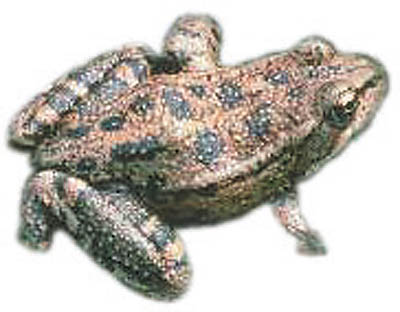A federal Circuit Court judge has thrown out the U.S. Fish and
Wildlife Service’s critical habitat designation map that claimed
more than 4 million acres to protect the California red-legged
frog.
A federal Circuit Court judge has thrown out the U.S. Fish and Wildlife Service’s critical habitat designation map that claimed more than 4 million acres to protect the California red-legged frog.
Federal Judge Richard Leon’s ruling was a disappointment to many of the frog’s champion where a large portion of northern San Benito County, the San Juan Valley and an area of Pinnacles National Monument were designated as a critical habitat.
The ruling eliminates all but 200,000 acres of federal land until a new study of the economic impacts is completed for the designated areas.
“In terms of balance, 75 percent of the frog’s habitat has been destroyed for development and paved over,” said Mike Sherwood, Earthjustice’s attorney who argued the case. “We are only trying to save a small fraction, about 25 percent is left.”
The critical habitat designation was included in the Endangered Species Acts, but it was not being enforced by USFWS until the agency was threatened with a lawsuit by Earthjustice in 2000. By March 2001, USFWS put together the map that some officials referred to as a “rush” job.
Three months later, the Home Builders Association of Northern California and other developers decided to challenge the land use restrictions that would have regulated parts of 28 of California’s 58 counties and filed a lawsuit to overturn the designation.
“What is real significant is of the 4 million acres in our view, vast amounts of territory designated is not occupied by the frog,” said Paul Campos, attorney for HBA. “The effects of the designation was to vastly expand their jurisdiction over land use.”
It was that critical designation map, which drew comments from San Benito County Water District Executive Director John Gregg. Gregg stated in the past it was interesting how the critical habitat designation in this region stopped at the the Parajo River, which separates San Benito and Santa Clara counties.
Bryan Morri, a consulting biologist based in Watsonville, works with developers throughout the county.
“On one hand the ruling is not going to change too much with the development of projects because they have to go through the California Environmental Quality Act process,” he said. “Developers still have to deal with the frog because federal takes are still going to be an issue.”
Morri has spotted the red-legged frog east of Fairview Road and has found a small population living at Ridgemark Golf and Country Club.
“They just move around,” Morri said. “They can be anywhere there is water, stock ponds and cattle ponds are inviting places.”
Earthjustice intervened in the lawsuit on behalf of several conservation groups, including the Jumping Frog Research Institute, the Center for Sierra Nevada Conservation, the Pacific Rivers Council, the Center for Biological Diversity and the Sierra Club.
Sherwood was disappointed to be excluded from the settlement talks, which he said created undue prejudice.
“That did not sit well with me,” he said. “The judge had a proposed agreement and judges love to have parties settle cases so there is prejudice to favor a settlement.”
The judge also ruled the way USFWS developed the map was illegal.
Mary Paxton, an assistant planner for the county, is working on a Habitat Conservation Plan that would identify areas of conservation that would include private and public land.
“We have been working with consultants and with Fish and Wildlife on a multi-species plan for a long time,” she said.
Also, the county recently received a grant to help with data gathering on the species found in the area.
“It will help us make better informed decisions,” Paxton said. “We still have to address the frog that lives here.”
Though the critical habitat designation was thrown out, there are other legal protections in place for the frog.
“They have vacated the critical designation for now, but just the fact the frog is listed under the ESA gives it protection,” Sherwood said. “It’s not the end of the road either. It now goes back to Fish and Wildlife to create a new critical designation.”
San Benito County Farm Bureau Water Committee Chairman Anthony Botelho said it was evident USFWS abused its powers if the courts had to overturn the habitats designations.
“I think that many people in fish and game had their way, the whole state would be critical habitat,” Botelho said. “That is why landowners and people who truly have knowledge of environmental management must continue to fight the overly zealous bureaucrats in fish and game.”
Sherwood said Earthjustice will decide if it will appeal the decision. Officials have until Jan. 5, and the revised map is scheduled to be completed by 2005.










